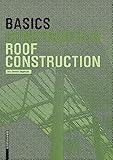Basics Roof Construction : New edition / Ann-Christin Siegemund; ed. by Bert Bielefeld.
Material type: TextSeries: BasicsPublisher: Basel : Birkhäuser, [2020]Copyright date: ©2021Description: 1 online resource (80 p.)Content type:
TextSeries: BasicsPublisher: Basel : Birkhäuser, [2020]Copyright date: ©2021Description: 1 online resource (80 p.)Content type: - 9783035619423
- 9783035619478
- 9783035619584
- 695 23
- TH2401 .S54 2021
- online - DeGruyter
- Issued also in print.
| Item type | Current library | Call number | URL | Status | Notes | Barcode | |
|---|---|---|---|---|---|---|---|
 eBook
eBook
|
Biblioteca "Angelicum" Pont. Univ. S.Tommaso d'Aquino Nuvola online | online - DeGruyter (Browse shelf(Opens below)) | Online access | Not for loan (Accesso limitato) | Accesso per gli utenti autorizzati / Access for authorized users | (dgr)9783035619584 |
Frontmatter -- Contents -- Foreword -- Introduction -- Basics and design factors -- Sloping roofs -- Roof construction -- Roof construction layers -- Flat roofs -- Additional components -- In conclusion -- Appendix
restricted access online access with authorization star
http://purl.org/coar/access_right/c_16ec
A roof over one’s head is a basic need – it provides shelter from rain, wind and the cold. In addition to these requirements, the structure must be load bearing and stable. Out of traditional craftsmanship, roof shapes and typologies have developed that fulfill these tasks and endure to this day. Basics Roof Construction describes the different kinds of roofs and which advantages and disadvantages each of them has. It explains which tasks are performed by the structural elements and layers and how to account for these in planning construction. The objective is to provide students with the principles, properties and technical terms of construction so that they can implement this knowledge in concrete design plans: from building, to insulation and sealing, all the way to the basics of drainage.
Das Dach über dem Kopf ist ein Grundbedürfnis – es schützt vor Regen, Wind und Kälte. Diese bauphysikalischen Anforderungen werden durch Lastenabtrag und Stabilität ergänzt. Aus handwerklichen Traditionen haben sich Dachformen und -typologien herausgebildet, die diese Aufgaben erfüllen und bis heute Bestand haben. Basics Dachkonstruktion erläutert, welche Arten von Dächern es gibt und welche Vor- und Nachteile sie haben. Es stellt dar, welche Aufgaben die konstruktive Elemente und Schichten übernehmen und wie sie planerisch zu berücksichtigen sind. Ziel ist es, den Studenten die Prinzipien, Eigenschaften und Fachbegriffe an die Hand zu geben, damit sie die Zusammenhänge in der konkreten Entwurfsplanung umsetzen können: von der Konstruktion über Dämmung und Abdichtung bis hin zu Grundlagen der Entwässerung.
Issued also in print.
Mode of access: Internet via World Wide Web.
In English.
Description based on online resource; title from PDF title page (publisher's Web site, viewed 01. Dez 2022)


